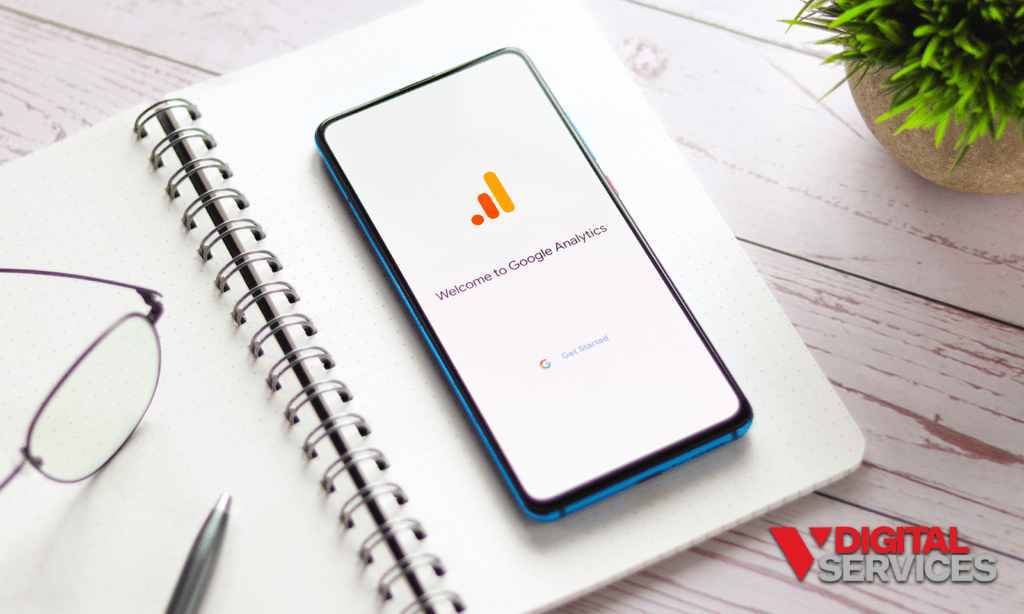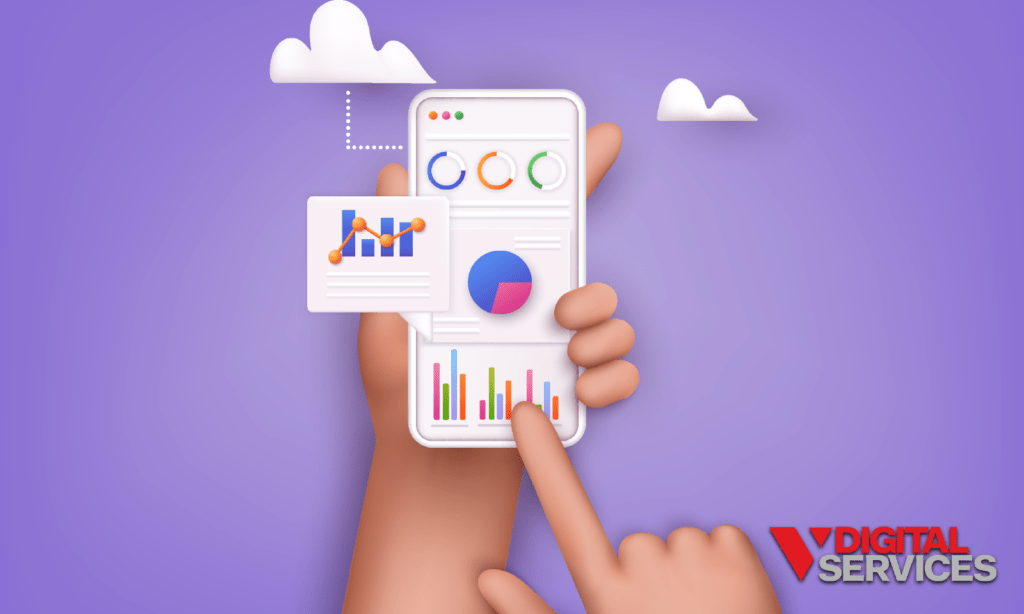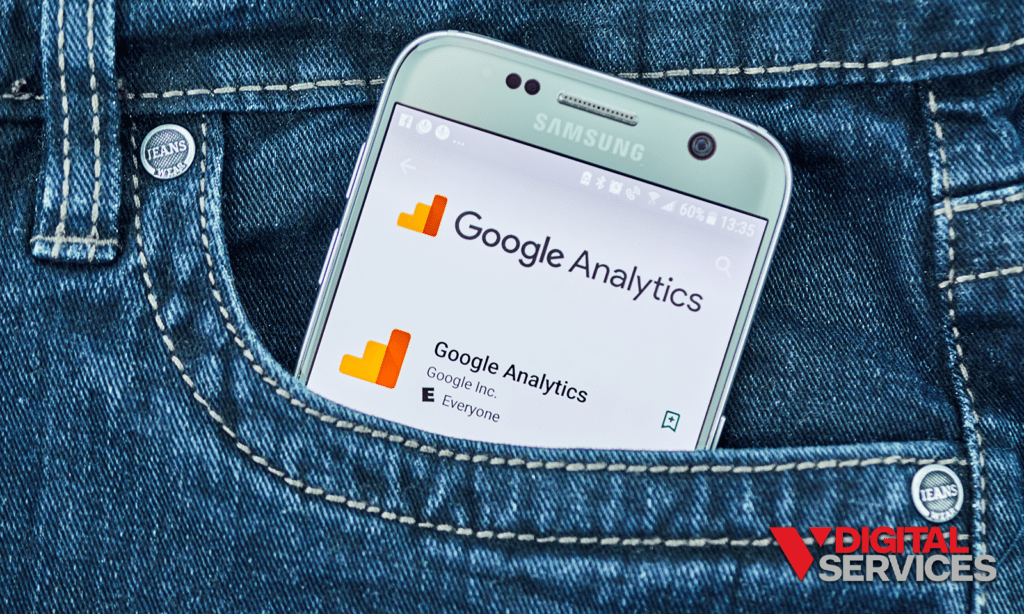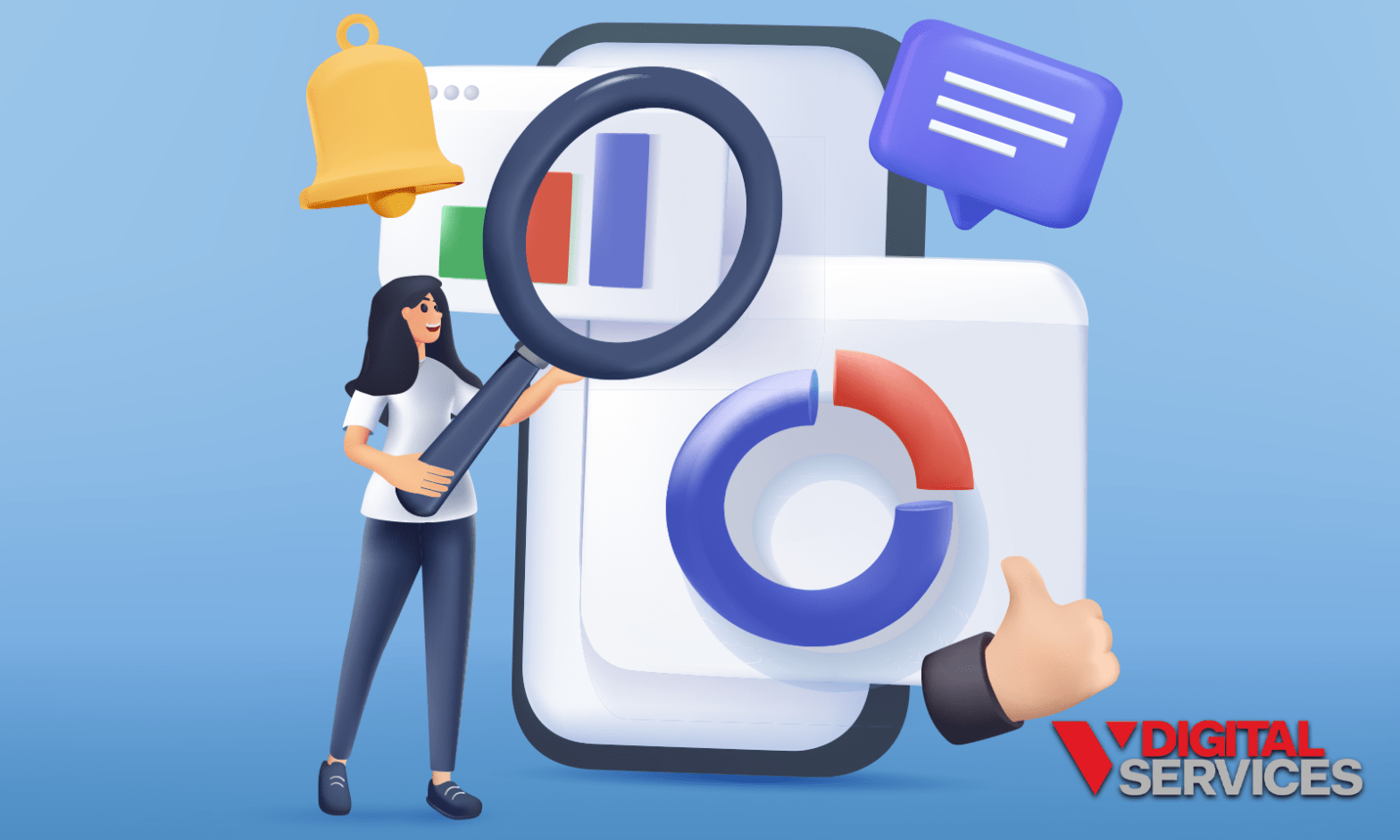Google Analytics 4 (GA4) is the new default for Google’s web analytics service, launched in October 2020. This version gives businesses a powerful suite of features that make it different from its predecessor, Universal Analytics (UA). GA4 uses artificial intelligence (AI) to fill in data gaps left behind by UA and greatly improves marketing channel analysis and KPI measurement. The user interface is also vastly improved to be more useful with lots of useful new insights.
The AI used by GA4 helps identify trends across multiple user interactions that could have gone unnoticed with the old UA system. For example, you can zoom out and look at sites by medium and channel instead of just individually to test how your website performs over time. With an easy-to-use UI, businesses can effectively receive detailed reports on their website performance so they can use this information to gain more insight into their customer journey and optimize their overall approach.
What Is Google Analytics 4?
GA4 is Google’s latest offering in the field of analytics and reporting. The system utilizes a next-generation approach to AI-based predictive data, privacy-first tracking, and x-channel measurement to deliver valuable insights about user engagement and behavior. GA4 also employs advanced machine learning (ML) models, allowing for more accurate website traffic analysis than previous versions of Google Analytics that relied on hit counts for each page.
The goal of GA4 is to provide powerful insights into user behavior with data from across devices, applications, and websites. Tracking events are also an important feature of GA4 as they help measure responses to advertisements and campaigns. Additionally, GA4 can detect when users opt out of cookies or other means of data collection due to browsers such as Mozilla Firefox blocking them by default. This makes it an incredibly useful tool for businesses and marketers who are constantly looking for new ways to measure success while adhering to users’ privacy rights.
Highlights of GA4
Google Analytics 4 (GA4) is the latest iteration of Google’s suite of web analytics tools and services. The biggest highlight of GA4 is its seamless integration with other Google-owned products such as Google Cloud, BigQuery, Firebase, etc., which makes it easier for businesses and developers to use analytics to fuel their decision-making process across all platforms. With ML capabilities also integrated into the system, users can gain even more insights from their data and create better UX experiences for website visitors.
Another major highlight of GA4 is its scalability. It has enriched features that allow users to track activities across devices, platforms, and websites—providing a comprehensive picture of customer engagement patterns. It also offers powerful segmentation and traffic filtering options to identify areas where improvements are needed and appropriately focus resources. Finally, it comes with advanced analytic capabilities that provide valuable insights into user behavior so that users can make smart decisions regarding marketing initiatives.
Integration with Google Tools
Google Analytics 4 (GA4) allows organizations to access great data insights by deeply integrating with Google tools. By connecting GA4 with YouTube, companies can better track the performance of their advertising campaigns, measuring such metrics as viewer engagement levels, bounce rate, and website events. As a bonus, users enjoy free access to the BigQuery Export feature even when using the free version of GA4 – something that was previously limited only to paid versions of Google Analytics.
Furthermore, GA4 offers several other advantages over previous versions regarding monitoring and managing customer behavior across devices. It does this by providing extra control when it comes to customizing audiences for targeted campaigns and creating customized subscriptions for each device used. Utilizing resource settings in BigQuery cloud storage also enables businesses to activate data collection as needed for further analysis of user behavior and engagement metrics. Overall, organizations stand to get a lot out of integrating their analytics solutions with Google tools through GA4.

Machine Learning
Google Analytics 4 (GA4) is a powerful tool for both marketers and businesses everywhere. Utilizing machine learning (ML) and natural language processing (NLP), GA4 allows users to predict customer conversions, enabling those in the marketing industry to optimize their efforts in converting visitors into paying customers. Furthermore, an additional feature of GA4 allows audiences to be developed and personalized for Google Ads, which further increases user ROI.
Moreover, GA4 also predicts customer behavior, allowing businesses to understand the evolving needs of their customers as demanded by the changing market. A recent update on GA4 even introduced estimates such as average revenue per user (ARPU), providing businesses with yet another way to better adjust their marketing strategies while investing smarter and increasing their return on investment. GA4 looks to continue growing its ML potential in order to better meet the needs of marketers and entrepreneurs around the world.
Cross-platform Analytics
Cross-platform analytics has been traditionally difficult to measure due to the lack of universal standards for visitor behavior. Analytics tools such as UA and Firebase have separate approaches and often provide inconsistent reports due to different methods for data recording, resulting in data that can’t be used together.
Google Analytics 4 (GA4) takes a new approach and aims to address these challenges. It uses an event-based approach that collects standardized information from multiple platforms and displays it all in one place. This feature provides visitors with greater accuracy across their path journey and improves the quality of data collected. By using GA4, marketers can use more detailed insights from their users’ behaviors which helps them make better decisions about products and campaigns.
In addition, users are given powerful tools that can track user behavior cross-platform, including the ability to retarget based on specific events, streamline marketing campaigns, identify correlations between online activity and offline behavior, detect potential issues with website performance, and more. With this new level of insight into customer behavior, businesses gain a stronger understanding of how their customers experience their services across different devices, enabling them to drive effective marketing initiatives that benefit both parties.

Quota Limits
Quota limits are an important feature of any API. They help ensure the system doesn’t receive too much data simultaneously, preventing user overloads and keeping the system running efficiently. Google has these quotas in place to ensure the API isn’t overwhelmed with requests, thereby protecting its integrity. The limits may differ depending on the project or usage and can be subject to change according to Google’s Developer Quota Resource page.
When setting quota levels, Google considers factors such as user traffic, usage patterns, and industry trends. For instance, if there is an increase in demand for services provided through an API, quotas may be temporarily adjusted to accommodate the extra requests. If users need more request power than their current quota allows, they can contact Google for assistance in finding a better solution that meets their needs. Additionally, some APIs have usage metrics that can be monitored in real-time so users can determine whether their current API use matches their desired goals and needs.
Switching to Google Analytics 4?
Google Analytics 4 (GA4) offers a number of distinct advantages for users. The most notable of these is its artificial intelligence and machine learning capabilities. This makes GA4 a better analytical tool since it can detect trends and even predict the future behavior of visitors on users’ websites. In addition, GA4 functions better than Google Analytics Universal (UA). For example, it can provide more accurate predictions of visitor behavior based on their data thanks to machine learning.
Another major benefit of GA4 is the codeless tracking of events. This feature allows users to track events like form fills, link clicks, and video plays without any coding knowledge. This feature also helps them monitor visitor activity in real time, giving them valuable insights into how visitors interact with their website. In other words, users no longer have to waste time manually setting up complex tracking snippets to capture accurate data points when using GA4 – they can do this quickly and easily with just a few clicks!
Are You Successful at Attracting Website Visitors from Different Channels?
Having a clear understanding of where your website visitors are coming from and what sources drive the most profitable traffic is crucial in optimizing the performance and success of any business’s digital marketing strategy. The utilization of Google Analytics 4 (GA4) enables you to gain insight into users, track conversions, and optimize engagement, yet gathering this valuable data can be tedious as you may have to navigate multiple areas and reports within GA4.
However, if you want to quickly assess how successful different channels are in attracting customers, you can use advanced analytics tools that monitor all of your key metrics, such as total users by country, all in one place. By mapping out where people are coming from using a detailed visual report, you can create targeted campaigns specifically tailored to each demographic and determine which message best resonates with them. This gives companies an advantage when it comes to refining their overall reach and driving better results in terms of customer acquisition.
How Does GA4 Help With Reporting?
Google Analytics 4 has revolutionized the way data is collected and reported. This new integrated platform gives businesses unprecedented insight into user behavior and website performance.
Perhaps the most crucial advantage of GA4 is its ability to bridge gaps in data collection for today’s multi-device, multi-platform environment. GA4 uses enhanced machine learning techniques such as cross-device tracking to connect website activity to a single user journey across multiple devices. Furthermore, this deep analysis helps fill in other gaps, such as missing click data due to browser incompatibilities or account-based marketing techniques.
Being able to easily follow users as they move between devices also makes reporting impactful, efficient, and easy to interpret. GA4 streamlines the reporting process allowing marketers to quickly identify key trends, conversion rates, and more, all while saving time one would traditionally spend manually piecing together reports from various platforms. With this data at their fingertips, savvy marketers can understand their customers’ behaviors and make decisions based on those insights.
Best Ways To Use Google Analytics 4 Reports
The Google Analytics 4 suite of reports is an incredibly powerful tool to gain insights from your website and marketing efforts, allowing you to make informed decisions about where to focus your efforts. GA4 has various reports focusing on different aspects of website traffic and performance. The home page report is a great place to start, as it summarizes overall traffic, conversions, and revenue for that property. This is best used as a quick check to ensure everything behaves as expected, such as finding where new users have come from and identifying top-performing campaigns.
By using the various features of the GA4 reports, you can form an understanding of how visitors interact with your site – from initial visits all the way through their user journey until conversion or sale, providing invaluable actionable data that you can use to refine your strategies. For example, you can segment data into device types or geographical locations to discover which areas drive more high-value customers or track customer behavior across multiple sessions against current objectives and goals. Advanced analytics like these will provide critical feedback that helps ensure long-term success.

Realtime Report
The Realtime Report is an incredibly powerful tool and is an essential report in the left navigation. It provides real-time data and visuals on events happening within the past 30 minutes. This can help you quickly verify that the tracking code is working and instantly view effects from YouTube videos. Additionally, you can get up-to-date snapshot views for new product drops, allowing for changes to be made, if necessary, as swiftly as possible.
One cool feature within Realtime Report is the “View User Snapshot,” which gives an instant view into all users who have interacted with your platform in that time frame, including data on their journey, such as source pages, visits, duration on each page, and more. All these insights will help you maintain a quality experience for every user who visits your platform while also helping you make quick decisions to improve conversions.
Life Cycle Reporting
Life Cycle reporting is essential to better understand user behavior and the conversion journey through their funnel. This type of assessment mirrors the four key stages of acquiring, engaging, monetizing, and retaining users – giving a comprehensive look at each stage from start to finish.
Life Cycle reports will show in detail how users enter the conversion funnel once they’re in it and give more details on demographics such as age and tech used. Metrics on engagement levels and user journeys towards converting into customers or re-engaging them can also be included. Google Analytics 4 (GA4) events allow marketers to track activities that take place after user entry into a funnel, such as a purchase or subscription – this data can then be used to report back effectively on customer life cycle journeys. Life Cycle Reporting has been invaluable when strategizing effective user acquisition and retention plans, helping optimize and improve overall campaigns.

Powerful Change in GA4: Analysis Hub
The Google Analytics 4 Analysis Hub is a revolutionary new feature likely to greatly benefit businesses. It’s like 14 different reports rolled into one, providing access to several advanced analytics techniques and data templates that weren’t available in previous versions of Google Analytics. With the Analysis Hub, users have the latest cutting-edge marketing insight at their fingertips without creating complicated code or using other outside software.
Data exploration and reporting have never been easier with the Analysis Hub’s automatic segmentation, built-in query tools, and intuitive data visualizations. It allows you to find hidden patterns to refine an existing marketing strategy or construct an effective one from scratch. You can use its patented AI technology for automated insights, pre-built segments, and custom tables for deeper analysis. Ultimately, marketers will be empowered with all the necessary information they need to make informed decisions about campaigns and website optimization fast!
Ready to Make The Switch to GA4?
When moving over to Google Analytics 4, beginning the onboarding process as soon as possible is important. This allows you to be better prepared for the transition and ensure you have a smooth data transfer. The setup is already part of the Google Analytics 3 admin, so you don’t have to do too much extra work. All you need to do is follow a few steps to create the property and get the right tracking codes in place in your HTML.
Another step is to export and save all of your historical data from Google Analytics 3 before making any changes. This allows you to keep track of how things were before transitioning to GA4 without losing any important information. Once you’ve saved all your historical data, you can set up GA4 and complete your onboarding process.
Stay Up To Date With SEO Services from V Digital Services – A Google Premier Partner
It is clear that GA4 is still a few months away (date set to July 1, 2023) from replacing Google Analytics as the default platform. Yet this does not mean that now is not the time to get it ready to use. It would be beneficial if organizations began putting some measures in place early rather than waiting until the very last minute when GA4 goes live. Doing so could prevent the loss of important data or any erroneous analysis due to unexpected changes.
V Digital Services is a Google Premier Partner that provides SEO services for businesses seeking a practical method for search engine optimization. Our company does not make unrealistic projections or empty promises.
Our digital marketing agency prioritizes transparency and integrity and works as your partner to achieve digital marketing success. We provide a vital service for your business by developing and implementing a unique SEO strategy for your brand.
Photo Cred: Jacob Lund/Red Vector/olesia_g/sdx15/dennizn


 PREVIOUS
PREVIOUS